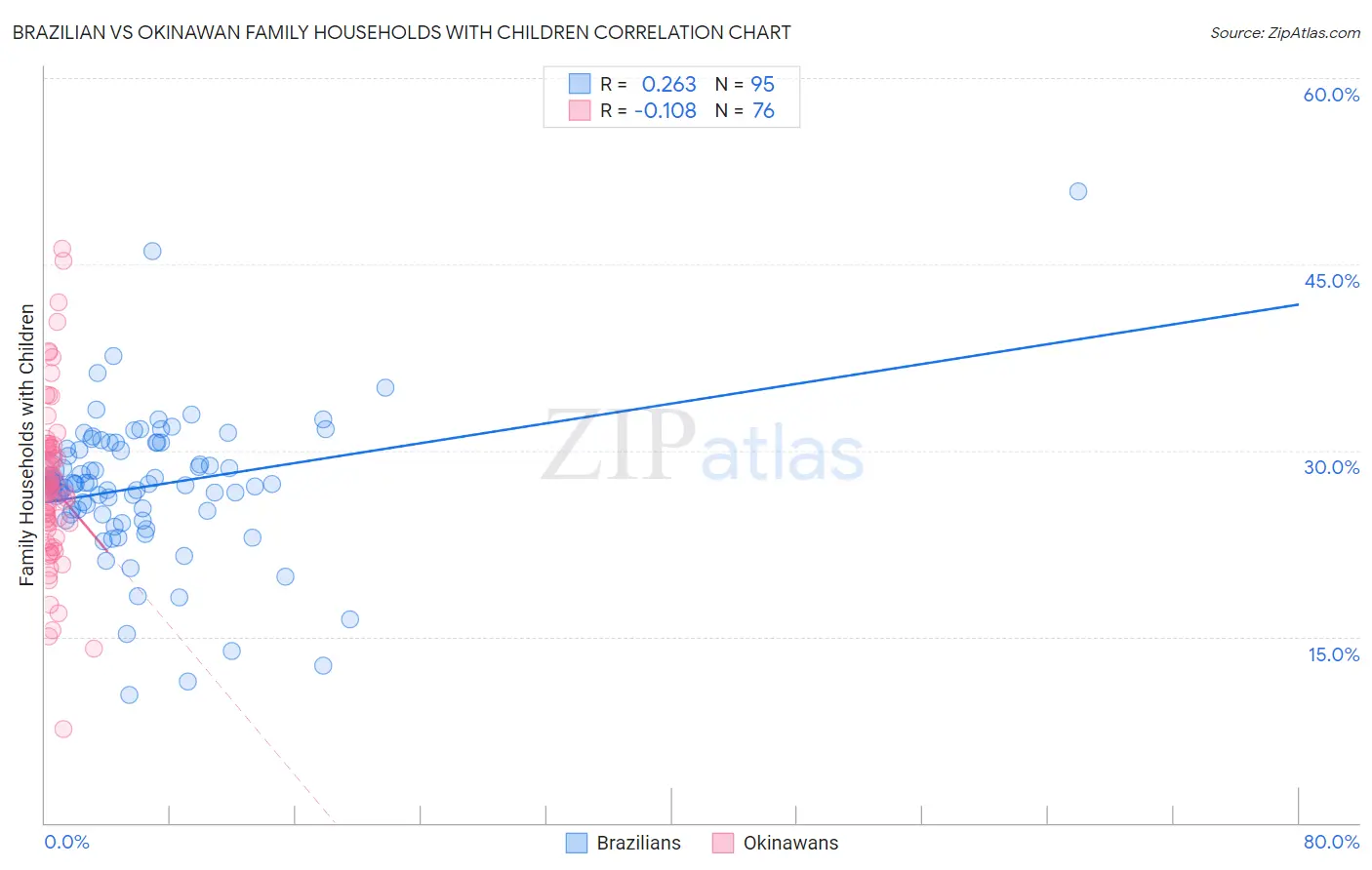Brazilian vs Okinawan Family Households with Children
COMPARE
Brazilian
Okinawan
Family Households with Children
Family Households with Children Comparison
Brazilians
Okinawans
27.7%
FAMILY HOUSEHOLDS WITH CHILDREN
79.6/ 100
METRIC RATING
144th/ 347
METRIC RANK
27.2%
FAMILY HOUSEHOLDS WITH CHILDREN
13.7/ 100
METRIC RATING
213th/ 347
METRIC RANK
Brazilian vs Okinawan Family Households with Children Correlation Chart
The statistical analysis conducted on geographies consisting of 323,614,103 people shows a weak positive correlation between the proportion of Brazilians and percentage of family households with children in the United States with a correlation coefficient (R) of 0.263 and weighted average of 27.7%. Similarly, the statistical analysis conducted on geographies consisting of 73,692,255 people shows a poor negative correlation between the proportion of Okinawans and percentage of family households with children in the United States with a correlation coefficient (R) of -0.108 and weighted average of 27.2%, a difference of 1.8%.

Family Households with Children Correlation Summary
| Measurement | Brazilian | Okinawan |
| Minimum | 10.3% | 7.6% |
| Maximum | 50.9% | 46.3% |
| Range | 40.6% | 38.7% |
| Mean | 27.1% | 27.2% |
| Median | 27.3% | 26.9% |
| Interquartile 25% (IQ1) | 24.9% | 23.9% |
| Interquartile 75% (IQ3) | 30.6% | 30.2% |
| Interquartile Range (IQR) | 5.7% | 6.3% |
| Standard Deviation (Sample) | 5.9% | 6.7% |
| Standard Deviation (Population) | 5.9% | 6.6% |
Similar Demographics by Family Households with Children
Demographics Similar to Brazilians by Family Households with Children
In terms of family households with children, the demographic groups most similar to Brazilians are Immigrants from Chile (27.7%, a difference of 0.010%), Basque (27.7%, a difference of 0.010%), Immigrants from Eastern Africa (27.7%, a difference of 0.020%), Immigrants from Moldova (27.6%, a difference of 0.020%), and Osage (27.6%, a difference of 0.020%).
| Demographics | Rating | Rank | Family Households with Children |
| Immigrants | Dominican Republic | 83.9 /100 | #137 | Excellent 27.7% |
| Uruguayans | 83.2 /100 | #138 | Excellent 27.7% |
| Vietnamese | 82.6 /100 | #139 | Excellent 27.7% |
| Spanish | 81.8 /100 | #140 | Excellent 27.7% |
| Immigrants | Eastern Asia | 81.7 /100 | #141 | Excellent 27.7% |
| Swiss | 81.4 /100 | #142 | Excellent 27.7% |
| Immigrants | Eastern Africa | 80.2 /100 | #143 | Excellent 27.7% |
| Brazilians | 79.6 /100 | #144 | Good 27.7% |
| Immigrants | Chile | 79.5 /100 | #145 | Good 27.7% |
| Basques | 79.5 /100 | #146 | Good 27.7% |
| Immigrants | Moldova | 79.1 /100 | #147 | Good 27.6% |
| Osage | 79.0 /100 | #148 | Good 27.6% |
| Menominee | 78.9 /100 | #149 | Good 27.6% |
| Argentineans | 78.5 /100 | #150 | Good 27.6% |
| Portuguese | 77.8 /100 | #151 | Good 27.6% |
Demographics Similar to Okinawans by Family Households with Children
In terms of family households with children, the demographic groups most similar to Okinawans are Immigrants from Dominica (27.2%, a difference of 0.010%), Welsh (27.2%, a difference of 0.020%), Immigrants from Ukraine (27.2%, a difference of 0.030%), African (27.2%, a difference of 0.040%), and Northern European (27.2%, a difference of 0.040%).
| Demographics | Rating | Rank | Family Households with Children |
| Immigrants | Micronesia | 20.2 /100 | #206 | Fair 27.2% |
| Haitians | 19.8 /100 | #207 | Poor 27.2% |
| Immigrants | Poland | 16.4 /100 | #208 | Poor 27.2% |
| Dutch West Indians | 15.8 /100 | #209 | Poor 27.2% |
| Immigrants | Ukraine | 14.4 /100 | #210 | Poor 27.2% |
| Welsh | 14.2 /100 | #211 | Poor 27.2% |
| Immigrants | Dominica | 13.9 /100 | #212 | Poor 27.2% |
| Okinawans | 13.7 /100 | #213 | Poor 27.2% |
| Africans | 13.0 /100 | #214 | Poor 27.2% |
| Northern Europeans | 12.8 /100 | #215 | Poor 27.2% |
| Cubans | 12.2 /100 | #216 | Poor 27.1% |
| U.S. Virgin Islanders | 12.1 /100 | #217 | Poor 27.1% |
| Greeks | 11.4 /100 | #218 | Poor 27.1% |
| Immigrants | Japan | 10.7 /100 | #219 | Poor 27.1% |
| Austrians | 9.9 /100 | #220 | Tragic 27.1% |